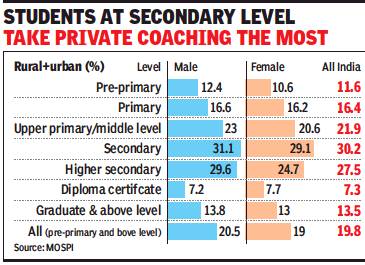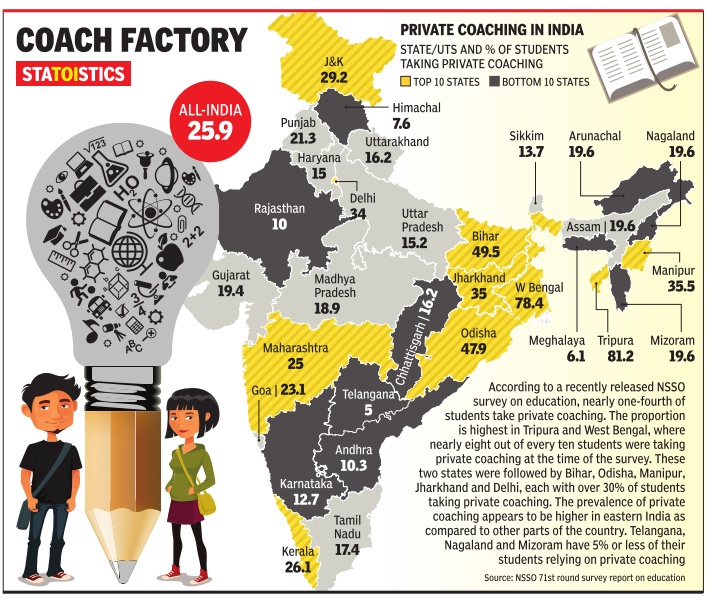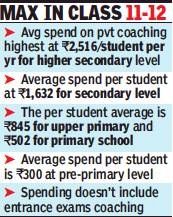Tutors, private tuition and coaching: India
This is a collection of articles archived for the excellence of their content. |
Contents |
Legality
Madras HC bars teachers from taking home tuitions
Sureshkumar K, April 15, 2019: The Times of India
School and college teachers doing business/trade or taking tuition, even after school hours, is misconduct, ruled the Madras high court on Tuesday. It also directed the Tamil Nadu government to create a helpline and display it prominently in schools to help parents and children file complaints on such matters and sexual harassment issues. Once a complaint is received, the government must take action in 24 hours, the court said.
Justice S M Subramaniam issued the directive while ruling on a petition filed by one R Renganathan, a corporation school headmaster, challenging his transfer to another school which was just 2km away from his present school.Ruing the growing indiscipline in government schools, more so among teachers, the judge said teachers were filing such unnecessary writ petitions without realising that they were duty-bound to serve the public.
The judge said that though as per rule 9 of Tamil Nadu Government Servants Conduct Rules a teacher could not engage themselves in any trade or business or undertake any employment, “the situation across the state is that most of the government teachers have engaged themselves in conducting tuitions/tutorials and private classes for monetary gain”.
“These teachers are receiving huge amount as remuneration from parents. It is most unfortunate to state that these teachers are soliciting students to join the tuition classes at their home or in the place organised by such teachers. Students, after school hours, are sometimes forced to attend tuition. Taking of tuition after school hours is also a misconduct,” Justice Subramaniam said.
Noting that such teachers are conducting agitations and dharnas during the eve of public examinations in order to ‘threaten the state government’ as well as the public, the court said that such activities of teachers are to be viewed seriously and actions are to be taken by the competent authorities.
Noting that there is no adequate machinery to check these illegal activities and initiate action, Justice Subramaniam said, “higher officials, who have knowledge about these activities, are remaining as mute spectators. Those higher officials are also committing a misconduct by not initiating proper actions against these public servants”. Observing that decent salary is being paid to these teachers by the government from the tax-payers money, the court added that they had a moral duty towards the society.
Stage at which students seek private tuition
As in 2017-18

From: Surojit Gupta, Secondary-level students take coaching most: Survey, July 21, 2020: The Times of India
Secondary level students topped the number of students taking private coaching with 31% males and 29% female students taking recourse to this method, a recent NSSO survey has shown.
The report also showed that nearly 20% students attending pre-primary and above level (21% of males and 19% of females) were taking private coaching.
According to the final report of the 75th round of the survey information was collected on whether a student was taking/had taken private coaching relating to the basic course. Private coaching might be taken by a student individually or in a group, at home or in any other place, by a single or more tutors.
Private coaching is a thriving business across the country and according to a 2016 NSSO report more than 7.1 crore students were taking private coaching or tuition classes in addition to their basic education.
At the pre-primary level 11.6% of students across the country were taking private coaching but this number rose gradually at the upper primary and middle level to 21.9% and rose to 30.2% at the secondary level. It then tapered to 27.5% at the higher secondary level.
Experts attributed the trend of a larger share of students at the secondary level taking recourse to private coaching to the entrance exams for professional courses such as engineering and medicines.
Anil Swarup, former secretary school education in the ministry of human resource development, explained the increase of students taking private coaching to the different competitive examinations and said this was a result of the dichotomy between learning and understanding.
Year-wise trends
2014: 7.1 cr students take coaching

The Times of India, Apr 05 2016
7.1cr students take pvt tuitions: NSSO report Parallel
Subodh Varma
Arecent NSSO report has taken the veil off what is called the shadow education system -private coaching and tuition, outside and parallel to the mainstream education system. The number of students taking such coaching classes or tuitions is estimated at 7.1 crore, almost 26% of the total number of students in the country .Of these, 4.1 crore are boys and 3 crore are girls.
The report estimates that about 11% to 12% of the total expenditure incurred by families goes for private coaching or tuitions. Contrary to expectation, poorer sections of society take recourse to pri vate coaching of kids practically as much as richer families, the report says. These details emerge from the NSSO report based on a survey of 66,000 households conducted in the first half of 2014.
However, NSSO estimates for populations have been known to vary from that of the Census. For example, Census 2011 counted 315 mil lion students as opposed to 273 million estimated by the NSSO. So, the number of students taking private coaching could well be higher than 7.1 crore. Over 89% of respondents said the main reason for going for private coaching was “augmenting basic education“. What they meant was that the schools were not up to the mark at least as perceived by the parents and students and hence they had to take supportive steps. Just four percent of the respondents said that private coaching was needed to prepare for exams for jobs or other educational institutes.
Among the poorest 20% of the rural population about 17% of students were taking coaching while this share rose to 25% for the richest fifth of the population. In urban areas, where coaching rates are generally higher, some 30% of students from the poorest fifth of the population went for coaching while the share was over 38 percent among the students from the richest 20%. This exhibits the widespread need felt for supplementary education.
At the state level, there was wide variation in the shares of students attending private coaching classes. The highest share was reported from Trip ura (81%) followed by West Bengal (78%). Expenditures on private coaching were also relatively high in these states while spending on course fees was on the lower side.
The survey found that students in govt. schools were spending more on private coaching with share such spend rising to 33% of the family's total spend on education when the kids were at the secondary stage. The flip side of the coin is that spending on education in private unaided institutions was 22 times that of government institutions.
State-wise figures

See graphic:
Private coachings in India, state-wise(these figures, to, seem to be from the 2014 survey.
2017-18
Atul Thakur, August 8, 2020: The Times of India

From: Atul Thakur, August 8, 2020: The Times of India
Indian families spend close to Rs 25,000 crore a year on giving school kids private tuitions, an analysis of data from the education ministry and a recent NSO report indicates. This does not include coaching for entrance exams and is just the money spent on bringing children from the pre-primary to the higher secondary level up to speed on their school courses.
To put that in context, the amount is more than one third the central government’s total budget allocation of Rs 59,845 crore to the department of school education and literacy.
Families of children in each of the primary, secondary and higher secondary levels spend over Rs 6,000 crore on private tuitions while the annual spend in the upper primary (or middle school) category is a bit over Rs 5,400 crore.
Data: Pvt coaching accounts for 13% of total education cost
These numbers are arrived at by combining the results of a recently released National Statistical Office (NSO)’s survey on education for 2017-18 and the education ministry’s data on the current number of students at various levels of schooling. The ministry’s figures don’t include pre-primary students, but even without them, the total adds up to Rs 24,081 crore. The survey shows that the average spent on private coaching per student is highest at Rs 2,516 at the higher secondary level, where a little over a quarter of students take such tuitions. The average annual spend per student is lower at Rs 1,632 for the secondary level, but the proportion of students who take tuitions is the highest here at just over 30%. The per student average is Rs 845 for upper primary and Rs 502 for primary school. Private tutors are hired at even the pre-primary level, where the average expenditure per student is Rs 300.
The data also shows that the overall cost incurred by parents for school education is about Rs 1.9 lakh crore, of which nearly half goes to school fees while a little over 20% is spent on books. Private coaching accounts for 13% of the total cost of education.
